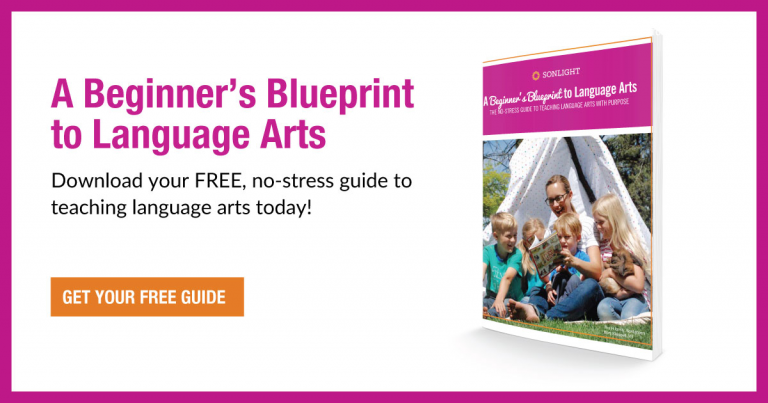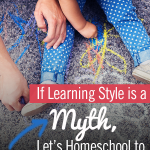There are many different schools of thought on how to categorize learning styles. Discover how your child's learning style or preference can impact how you approach homeschooling.

My four children are all so very unique that it would be difficult, if not impossible, to teach them all the same way. Chances are, your children are the same way. As a homeschool mom, it can be challenging to figure out the best ways to tailor your child’s homeschooling curriculum and learning experiences for maximum enjoyment and comprehension. So first, you’ll need to determine which learning style best fits your child and the topic at hand.
There are many different schools of thought on how to categorize learning styles. For the purposes of this post, we’ll use the simplest three learning styles: visual, auditory, and kinesthetic.
Although some research calls learning styles a myth, we can all agree that everyone has preferences. Some kids love to write while others would prefer to talk out their ideas. Some children love to consume their lessons through video. Some students would rather whiz through a printed book than listen to a slow audio. We are all unique! And the beauty of homeschooling is that we can provide abundant options to our children to learn in the most comfortable ways while still stretching them at times to use their less preferred avenues of learning.
So whether we call them styles or preferences, the bottom line is the same—vary and customize the ways you homeschool to provide maximum enjoyment and learning.
1. Visual Learning Style or Preference
Does your child love pictures? Can they “read” a book simply by looking at the pictures? Do they have a photographic memory? Do they remember faces? Do they need to see something to learn it? Do they struggle listening to read alouds, lectures, or sermons? If you answered yes to any of these questions, you might have a visual learner on your hands.
To best meet the needs for a visual learner:
- use graphic organizers and mind maps as often as possible,
- during read alouds, always think of photos you could show or videos that might support the content,
- allow them to draw a picture of what they hear while you read aloud,
- watch the movie after reading the book, or watch clips of the movie as you read the book,
- break down math problems into simple steps and make detailed notes to show how and why it works,
- use visual aids like base ten blocks or an abacus so they can visualize what’s happening,
- diagram sentences in grammar lessons, and/or
- use pictures as clues to help with memorization (i.e. a heart beside a picture of the world could trigger the memory verse John 3:16).
2. Auditory Learning Style or Preference
Does your child love for you to read aloud to them? Do they seem to learn things best when they hear it? Do directions only make sense if you read them aloud? Do they easily pick up the words to songs after just a few times of hearing it? Do they remember names of people more than faces? If so, you might find yourself with an auditory learner.
To help your auditory learner excel, try the following tips:
- read directions aloud
- discuss everything and discuss often
- use songs, rhymes, raps, and mnemonic devices to help memorize facts
- read aloud often or use audiobooks
- have them read their work into a recorder and play it back to themselves
3. Kinesthetic Learning Style or Preference
Kinesthetic kids are generally your movers and shakers who love to move their bodies. This preference translates to their learning as well. Does your child love to move? Do they fidget? Can they just not seem to be still? Do they want to touch everything? If you answered yes, say hello to the kinesthetic world! All very young children fall into this preference, so the younger your child, the more physical techniques you need to employ.
- Think hands-on; use manipulatives for math.
- allow them to move as much as possible, take lots of short breaks along with a few good long breaks
- encourage them to go outside and run if they seem antsy
- let them fidget
- get creative with your seating; kinesthetic learners are the ones you’ll find hanging upside down off the couch
- provide experiences (i.e. If you’re learning about animals, go to the zoo.)
Some of you are probably like me—lucky enough to have at least one of each! Don’t stress. This is actually no big deal once you get used to it. Simply make sure you’re incorporating a little of each learning style into your day.
Remember that you don’t have to treat your children the same. You know your children the best, so you get to decide what’s best for them. You may find yourself on the edge of your seat in the middle of a stellar read aloud with one child drawing during, one child intently listening, and one pacing behind the couch. Congratulations! You’re doing it! You’re meeting every single need at the same time. This is exactly what a multi-learning style homeschool should look like.
Of course, by the end of the day, you’ll want to start thinking about your own learning style again. Depending on your your personal style, you’ll want to treat yourself by either watching some Netflix, soaking in a bath with a good podcast playing, or going for a nice, long walk! Whatever you choose to do, enjoy it! You’ve earned it.
Your Curriculum Style Goes Hand-in-Hand with Learning Preference
Get a head start on homeschool happiness with one simple secret: you do NOT have to replicate a "normal" classroom in your home.
Homeschooling is all about freedom. And that includes freedom to choose the style of schooling that fits your family best. You have a multitude of homeschooling curriculum options out there—from textbooks that look just like the ones you used in school, to ultra-relaxed "unschooling." Some basic approaches to curriculum include:
- Traditional/Textbook
- Unit Studies
- Literature-Based/Living Books
- Classical Education
- Unschooling/Relaxed Homeschooling
So ... what do these mean? Which might fit you well? Click here for a free e-book: 7 Secrets to Finding the Best Homeschooling Curriculum.
Learning preferences significantly influence homeschooling approaches. Children who thrive with hands-on activities often benefit from experiential education models that incorporate physical manipulation, projects, and real-world applications. For these kinesthetic learners, curriculum choices might emphasize nature studies, science experiments, building projects, and arts integration. Conversely, children with strong auditory or visual learning preferences might excel with different approaches—perhaps literature-based curricula for auditory learners or graphic-rich resources for visual processors.
For more teaching helps, get our free guide A Beginner’s Blueprint to Language Arts: The No-stress Guide to Teaching Language Arts with Purpose. Download it here at no cost.









Hi! Great post! I cannot fully agree with what is stated in the article to which you refer: https://www.wired.com/2015/01/need-know-learning-styles-myth-two-minutes/
I prefer this article, which reveals the problem with learning styles and gives tips on improving the learning experience: https://ivypanda.com/blog/the-problem-with-learning-styles-and-how-to-use-it-to-your-benefit/. Hope it will be a useful addition to everything said.